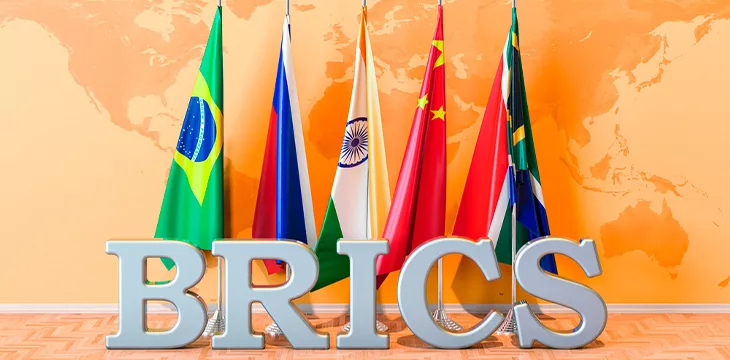|
Getting your Trinity Audio player ready...
|
In January 2024, Iran, Egypt, Saudi Arabia, Ethiopia, and the United Arab Emirates joined the BRICS (Brazil, Russia, India, China, South Africa) alliance, a group of emerging economies seeking more influence in international politics.
Now, a Russian official, Sergei Ryabkov, has told TV BRICS that the alliance is considering using stablecoins for settlements. This is in addition to the special communications channel set up between BRICS central banks.
While no specific details were provided as to what stablecoins or blockchains might be used, Ryabkov confirmed that the “BRICS Bridge” is still being discussed. The platform would interlink central bank digital currencies (CBDCs) between BRICS countries, fostering greater economic cooperation between them.
Moscow has been advocating for a blockchain-based solution for months in the wake of increasing U.S. sanctions due to the war in Ukraine. Russia is currently testing its digital ruble with over 25,000 successful transactions as of March 2024.
Uncle Sam is getting spooked by stablecoins
In a related report, a paper by the Brookings Institute showed that the proliferation of dollar-backed stablecoins is causing concern in Washington.
Of particular concern is the fact that, unlike with eurodollars, the U.S. has effectively no control over how stablecoins are used. Thus, it is unable to impose sanctions on those seeking to use them.
The paper called for more robust stablecoin regulation as Senator Elizabeth Warren (D-Mass.) called for enforcement of anti-money laundering rules at the wallet and validator levels.
BRICS challenges the United States’ financial hegemony
There’s no doubt that the U.S. is still firmly on top when it comes to the world economic system. Not only does the U.S. Navy patrol the world’s oceans and make free trade possible, but the U.S. dollar is still the primary reserve currency by a large margin.
Challenger economies like China simply do not have equivalent global financial centers, deep capital markets, and a free-floating currency, all of which would be required to pose a serious threat to the USD. To this day, most U.S. dollar payments pass through the U.S., making it possible for the country to use payment mechanisms as sanctions starting in the early 2000s.
Russia, in particular, has questioned whether the U.S. dollar should have the status it does and is calling for alternatives. After having approximately $300 billion in assets frozen, Russia has been seeking alternative ways to make and receive payments with economic partners.
BRICS’ use of stablecoins and its CBDC bridge would go some way toward challenging the U.S. dollar’s hegemony. While it’s unlikely the rest of the world will adopt the Russian Ruble, Chinese RMB, or Brazilian Real as a reserve currency anytime soon, the goal is to have an alternative way to pay and be paid between themselves.
We await further details on BRICS’ use of stablecoins and blockchain technology to settle payments between members and will report on them in due course. Subscribe to CoinGeek.com for the latest updates.
To learn more about central bank digital currencies and some of the design decisions that need to be considered when creating and launching it, read nChain’s CBDC playbook.
Watch: Spotlight on Centi Franc—the truly stable stablecoin

 09-06-2025
09-06-2025 





